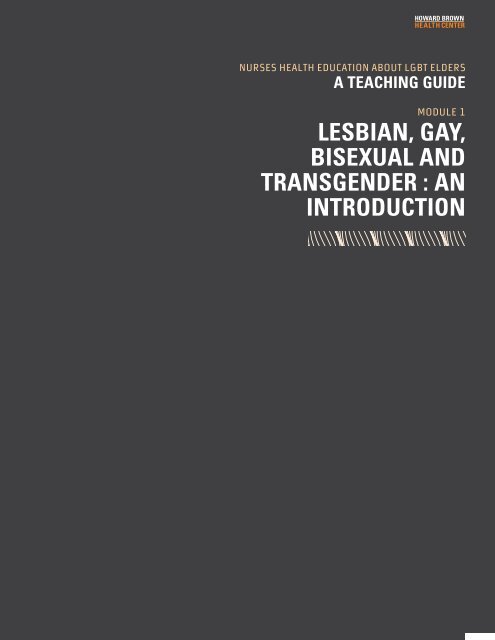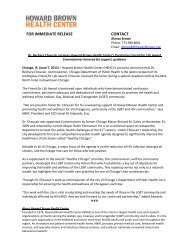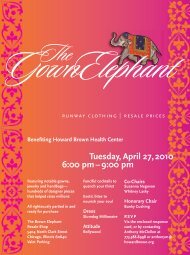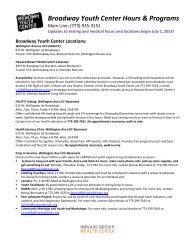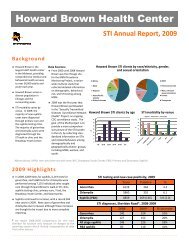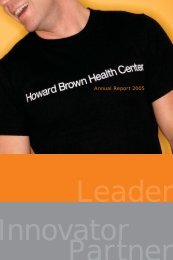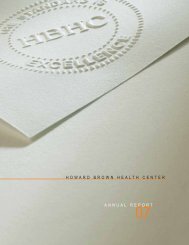An Introduction to LGBT Elders - Howard Brown Health Center
An Introduction to LGBT Elders - Howard Brown Health Center
An Introduction to LGBT Elders - Howard Brown Health Center
- No tags were found...
Create successful ePaper yourself
Turn your PDF publications into a flip-book with our unique Google optimized e-Paper software.
HOWARD BROWN<strong>Health</strong> <strong>Center</strong>Nurses <strong>Health</strong> Education About <strong>LGBT</strong> <strong>Elders</strong>A Teaching GuideModule 1Lesbian, Gay,Bisexual andTransgender : <strong>An</strong>introduction
Guide <strong>to</strong> using the Teaching guideMODULESLIDE 1Module Number12SLIDE34InterveneSeek <strong>to</strong> end the harassment (physical or verbal) immediately.Create a physical barrier (including standing between) or distance between theharasser and the harassed.Follow UpDon’t try <strong>to</strong> collect information while you try <strong>to</strong> de-escalate the situation as itwill only increase the escalation.Gather information using open-ended questions.Provide reality check’s based on what you observed and heard.!CYU ( SLIDES 1-14)Prompt participants with questionsfound in the discussion guide(1-14) and ask them <strong>to</strong> discuss with1-2 people sitting near them.RDanish Shoes (1685). ScandanavianHis<strong>to</strong>ry of Footware. Retrievedfrom http://www.danishfeets.sd/info/his<strong>to</strong>ryofshoesArea for activities or references.Abbreviations are used and theLegend <strong>to</strong> the meaning of iconsis provided below56Presentation NotesLegendR!ReferencesCheck Your UnderstandingParticipant handoutContinued <strong>to</strong> the next pagePrompt Reflection ActivityTry ItNurses <strong>Health</strong> Education About <strong>LGBT</strong> <strong>Elders</strong> : Teacher’s Guide2
SLIDE 1MODULE1234Welcome! Before we begin,Let’s discuss the packet of papers you have in front of you. You should have onesheet that is a pre-test and post-test. Copies of the slide content and the lastpage is an evaluation.56I’m going <strong>to</strong> ask you <strong>to</strong> take the pre-test NOW. This will tell me what you knownow, then after our discussion I will ask you <strong>to</strong> take it again. This measures howwell I am able <strong>to</strong> teach you.Then, at the end of the session, I will ask you <strong>to</strong> fill out the evaluation. Thisinformation is very important <strong>to</strong> us so I want you be honest, tell us what you likeand dislike, do you think it was relevant and helpful. We use this information<strong>to</strong> edit the content as seems necessary. Also, ask any questions that you may beshy about asking in front of your peers. Then I will return next week and answeryour question, keeping the person who asked the question confidential. If oneperson has a question, probably someone else does <strong>to</strong>o!Our time <strong>to</strong>gether is casual, if you have a question, put your hand up and I’ll behappy <strong>to</strong> answer for you.Nurses <strong>Health</strong> Education About <strong>LGBT</strong> <strong>Elders</strong> : Teacher’s Guide3
SLIDE 2MODULE1234Describe the grant project.Started in 2009 and followed these steps…through 2012.■ Curriculum research/development■ Pilot presentations <strong>to</strong> academic settings, community-based clinics and longtermcare facilities■ Evaluation by like minded peers in the field of Geriatrics and Geren<strong>to</strong>logy■ Revision in content■ Creation of online products■ Establishment of website for dissemination■ Presentation of findings56<strong>Howard</strong> <strong>Brown</strong> <strong>Health</strong> <strong>Center</strong> is the Midwest’s premiere provider of health careand community services <strong>to</strong> the <strong>LGBT</strong> community since 1974.<strong>Howard</strong> <strong>Brown</strong> <strong>Health</strong> <strong>Center</strong> exists <strong>to</strong> eliminate the disparities in health care experiencedby lesbian, gay, bisexual and transgendered people through research, educationand the provision of services that promote health and wellness.Nurses <strong>Health</strong> Education About <strong>LGBT</strong> <strong>Elders</strong> : Teacher’s Guide4
SLIDE 3MODULE1234We offer this training with no commercial bias, I am not trying <strong>to</strong> sell you anything,I don’t work for a pharmaceutical company, I don’t even want you <strong>to</strong> comeat work at <strong>Howard</strong> <strong>Brown</strong>, even though it’s a great place <strong>to</strong> work. All nurses willreceive 1 continuing education unit for each module you attend.56<strong>An</strong>d, more importantly, I am not here <strong>to</strong> dissuade anyone from their personalbeliefs. I acknowledge that we are all different, I am here <strong>to</strong> provide you withinformation that will allow you <strong>to</strong> be better informed, more sensitive care giversfor your <strong>LGBT</strong> <strong>Elders</strong>.I am here <strong>to</strong> present this information, all 6 hours, in the context that nurses andhealthcare professionals we strive <strong>to</strong> have as much knowledge as possible, <strong>to</strong> betterserve our patients. I will say for the first time of many, that personal bias hasno place in the medical encounter.We became nurses, providers, <strong>to</strong> promote the health of our patients and do it ina caring effective way. That is the focus of bringing you this information. So aswe go along, always keep in the back of your mind, our ultimate goal is excellentpatient care.Nurses <strong>Health</strong> Education About <strong>LGBT</strong> <strong>Elders</strong> : Teacher’s Guide5
SLIDE 4MODULE1234We will cover these <strong>to</strong>pics in the next hour…56SLIDE 5We will go over these objectives…ASK NOW: Who can define cultural competency?Nurses <strong>Health</strong> Education About <strong>LGBT</strong> <strong>Elders</strong> : Teacher’s Guide6
SLIDE 6MODULE123Let’s talk about that…Who would say that they treat all their patients the same?We are talking about cultural competency, saying we treat everyone the same iscultural blindness. We need <strong>to</strong> be aware of all aspects of culture.DSAsk learners <strong>to</strong> describe whatthey think culturally competent care isbefore sharing Joint Commission 2010definition.456So what is culture? Shared aspects of life? Give some examples…■ Values, expectations, beliefs, attitudes■ Age, gender, race/ethnicity■ Sexual Orientation■ Language, his<strong>to</strong>ry, geography, cus<strong>to</strong>ms, rituals■ Food, clothing, music, art■ Religion■ Education, literacy, occupation, income, class, social status■ ETCWhy is cultural competence so important <strong>to</strong> <strong>LGBT</strong> Elder patients?■ Sexual diversity is often taboo, so we see:■ Stereotypes■ Misconceptions■ Myths■ Disrespect/ DiscomfortLeading <strong>to</strong> possible rejection from providers!Our patients count on us, expect us, <strong>to</strong> not only care, cure, treat them, but also <strong>to</strong>RESPECT THEM!Nurses <strong>Health</strong> Education About <strong>LGBT</strong> <strong>Elders</strong> : Teacher’s Guide7
SLIDE 7MODULE123What is one of the first things we learned in nursing school?Therapeutic communication, learn <strong>to</strong> have a therapeutic relationship with yourpatient. How? We need <strong>to</strong> get <strong>to</strong> know them.2011 Joint Commission guidelines specify The hospital prohibits discriminationbased on age, race, ethnicity, religion, culture, language, physical ormental disability,socioeconomic status, sex, sexual orientation, and genderidentity or expression.The <strong>Center</strong> for Disease Control states (CDC): Special Populations Identifiedincludes Risk Status Related <strong>to</strong> Sex & Gender: <strong>LGBT</strong> <strong>Health</strong>, Men who havesex with Men (MSM) & Lesbians. “There is . . . a need for culturally competentmedical care and prevention services that are specific <strong>to</strong> this population. Socialinequality is often associated with poorer health status, and sexual orientationhas been associated with multiple health threats. Members of the <strong>LGBT</strong> communityare at increased risk for a number of health threats when compared <strong>to</strong> theirheterosexual peers.[1-5] Differences in sexual behavior account for some of thesedisparities, but others are associated with social and structural inequities, such asthe stigma and discrimination that <strong>LGBT</strong> populations experience.”This is unquestionably a group in need of awareness and sensitivity.NOTERemind participants that the purposeof this and future modules is <strong>to</strong> acquireknowledge, assess themselves, and learnskills <strong>to</strong> deliver culturally competentcare <strong>to</strong> <strong>LGBT</strong> elders456Nurses <strong>Health</strong> Education About <strong>LGBT</strong> <strong>Elders</strong> : Teacher’s Guide8
SLIDE 8MODULE1234RUS <strong>Center</strong>s for Disease Control(2010). Lesbian, bay, bisexual,and transgender health. Retrieved fromhttp://www.cdc.gov/lgbthealth/index.html56SLIDE 9Joint Commission, The. (2010). Advancingeffective communication,cultural competence, and patient- andfamily-centeredcare: a roadmap forhospitals. Retrieved from http://www.jointcommission.org/assets/1/6/ARoadmapforHospitalsfinalversion727.pdfKaiser Permanente National DiversityCouncil. (2004). A provider’s handbookon culturally competent care: Lesbian,gay, bisexual and transgendered population.(2nd ed.). Oakland, CA: KaiserPermanente.SLIDE 10Nurses <strong>Health</strong> Education About <strong>LGBT</strong> <strong>Elders</strong> : Teacher’s Guide9
SLIDE 11MODULE1234Define the 4 terms. There are many more, but <strong>LGBT</strong> covers the group as awhole.“Lesbian and Gay refer <strong>to</strong> individual people who are romantically and or sexuallyattracted <strong>to</strong>, and or partner with people of the same gender”.“Bisexual people refer <strong>to</strong> individual people who are romantically and or sexuallyattracted <strong>to</strong> and or partner with people of more than one gender”.“Transgender describes people who identify with or express a gender differentfrom the sex assigned <strong>to</strong> them at birth”.Address the QQAAI2-s:■ Queer■ Questioning■ Alternative■ Ally■ Intersex■ Two-SpiritDefine Homophobia: The irrational fear of <strong>LGBT</strong> individuals.Define Heterosexism: The universal view that “straight” is natural, normal,expected, and superior. “Everywhere I look I see straight people…” Where do welook <strong>to</strong> affirm ourselves in the world? Case Study: Young latina woman in 1960’slooks at b/w TV and sees what? Who looks like her on TV? Look <strong>to</strong> media images,TV, magazines, the world around us for validation.Can you tell by looking at someone if they are Gay? No…Do experts agree that homosexuality is a choice? No…There are many other terms that <strong>LGBT</strong> people may choose <strong>to</strong> use <strong>to</strong> describethemselves but providing a complete list would be impractical, if not impossible,since new terms are frequently being introduced. In addition, many of the termsbeing used by younger <strong>LGBT</strong> people (such as “queer”) are not often embraced byolder adults. A good suggestion is <strong>to</strong> simply ask your patient how they choose <strong>to</strong>identify and then mirror their language. If you are not familiar with the term thatthey use, ask them <strong>to</strong> explain what it means <strong>to</strong> them.RGrant, J. M. (2010). Outing age:Public policy issues affectinglesbian, gay, bisexual and transgenderelders. Retrieved from http://www.thetaskforce.org/downloads/reports/reports/outingage_final.pdf56Nurses <strong>Health</strong> Education About <strong>LGBT</strong> <strong>Elders</strong> : Teacher’s Guide10
SLIDE 12MODULE123The terms sex, gender and sexual orientation are often used interchangeably.Despite sounding similar, they actually have three distinct meanings.SexBiological maleness or femaleness. Males have XY chromosomes. Females haveXX chromosomes. Sex is determined the instant a woman’s egg is fertilized bya man’s sperm. If an X sperm fertilizes an X egg, the fetus will be female. If a Ysperm fertilizes the X egg, the fetus will be male.GenderThe behavioral, cultural, and psychological traits typically associated with onesex. Babies are usually assigned a male gender at birth if they have a penis, and afemale gender if they have a vulva.Sexual OrientationA term used <strong>to</strong> refer <strong>to</strong> a person’s emotional, romantic, and sexual attraction <strong>to</strong>individuals of a particular gender (male or female).Gender IdentityA person’s inner sense of being male or female, usually developed during earlychildhood as a result of parental rearing practices and societal influences andstrengthened during puberty by hormonal changes.These combined give us a picture of identity, it is an important part but itis not everything.TIIdentity Pie… explain the functionof this exercise.RGender. (n.d.). In Merriam-Webster’sMedical Dictionary. Retrievedfrom: http://dictionary.reference.com/browse/genderGender identity. (n.d.). In RandomHouse Dictionary. Retrieved from:http://dictionary.reference.com/browse/gender+identitySexual orientation. (n.d.). In WebMD.Retrieved from http://www.webmd.com/sex-relationships/guide/sexualorientation456Nurses <strong>Health</strong> Education About <strong>LGBT</strong> <strong>Elders</strong> : Teacher’s Guide11
SLIDE 13MODULE1234In a 2003 survey by the <strong>Center</strong> on Halsted…Demographic estimates are just that, estimates due <strong>to</strong> a lack of census data on<strong>LGBT</strong> people of all ages. Estimated at 5-10% of the population-some consensus.Research and collection of <strong>LGBT</strong> data poor at best. Allows for “homogenous”view of the <strong>LGBT</strong> community.Stereotypical homosexual: Young, active, partying with <strong>to</strong>es in the sand and amarguerita, lots of disposable income. Right?There will be nearly 2 <strong>to</strong> 7 million <strong>LGBT</strong> elders in the United States by 2030.Estimate 40,000 in Chicagoland at present.Some estimates of 75% older <strong>LGBT</strong> adults live alone. Most of those adults arewomen.Most <strong>LGBT</strong> adults live alone: multiple studies portray that many <strong>LGBT</strong> peoplelive alone, much more than the general population.What are hazards of elders living alone?: Greater risk from falls, depression, substanceabuse and malnutritionFour times as likely <strong>to</strong> have no children. Children are a safety net!RBeauchamp, D., Skinner, J., andWiggins, P. (2003). <strong>LGBT</strong> personsin Chicago: Growing older: A survey ofneeds and perceptions: Chicago Taskforce on <strong>LGBT</strong> aging. Retrieved fromhttp://www.centeronhalsted.org/programs/growing_older.pdfGrant, J. M. (2010). Outing age: Publicpolicy issues affecting lesbian, gay,bisexual and transgender elders. Retrievedfrom http://www.thetaskforce.org/downloads/reports/reports/outingage_final.pdf56Nurses <strong>Health</strong> Education About <strong>LGBT</strong> <strong>Elders</strong> : Teacher’s Guide12
SLIDE 14MODULE1234Module 2 covers Barriers <strong>to</strong> Care/<strong>Health</strong> DisparitiesWhy do people go <strong>to</strong> the doc<strong>to</strong>r?How do they feel when they come in<strong>to</strong> care?Fear of discrimination may be based on: Real life experience, how a person istreated in the world at large vs. how they are treated in the health care system?They will believe that the experience they have in real-life may also happen <strong>to</strong>them in the health care setting. For these reasons:■ Personal experiences in the past with medical providers■ Experiences relayed by other <strong>LGBT</strong> people: When you have a bad mealat a restaurant, who do you tell?■ Concern that societal homophobia will also occur in the medical setting:If someone comes in<strong>to</strong> your facility or setting and someone makesa deroga<strong>to</strong>ry comment, everyone knows racial slurs are unacceptable andthey know <strong>to</strong> keep their mouths shut. It is not always the case for <strong>LGBT</strong>people.What is MY level of discomfort and what can I do <strong>to</strong> change it? How can I bethe most effective provider?■ As nurses, it is important <strong>to</strong> examine one’s own beliefs and understandhow they affect the many aspects of patient care.■ You may not approve of everything you encounter in patient care it, oragree that person’s actions, and some things you may encounter will goagainst strongly held religious or moral beliefs.■ It is important for you <strong>to</strong> be aware of those beliefs and as a medical professionalcontinue <strong>to</strong> give compassionate care with empathy and act in allways as the patient’s advocate so you can deliver the quality care that everypatient deserves.■ Through education, we can become more aware of our own feelings andprejudices and address them as we strive <strong>to</strong> provide care in a non-judgmentalmanner.RGay and Lesbian Medical Association(GLMA). (2010). <strong>Health</strong>ypeople 2010: Companion documentfor lesbian, gay, bisexual, and transgender(<strong>LGBT</strong>) health. Retrieved fromhttp://www.glma.org/_data/n_0001/resources/live/<strong>Health</strong>yCompanionDoc3.pdf p. 56Grant, J. M. (2010). Outing age: publicpolicy issues affecting lesbian, gay,bisexual and transgender elders. Retrievedfrom http://www.thetaskforce.org/downloads/reports/reports/outingage_final.pdfpp. 69-73Lambda Legal (2010). When healthcare isn’t caring. Retrieved from http://data.lambdalegal.org/publications/downloads/whcic-report_when-healthcare-isnt-caring.pdfpp. 10-1356Nurses <strong>Health</strong> Education About <strong>LGBT</strong> <strong>Elders</strong> : Teacher’s Guide13
SLIDE 14 (Cont’d)MODULE1234Case StudyBenitez case, a woman went <strong>to</strong> a privately funded health clinic for in-vitro fertilization.She was denied care because they did not approve of a family unit of lesbians.For nearly a year starting in August of 1999, Guadalupe “Lupita” Benitezwas denied infertility treatment by the North Coast Women’s Care MedicalGroup because she is a lesbian. Her former doc<strong>to</strong>rs are conservative Christianswho claim their religious beliefs give them a right <strong>to</strong> withhold care from Benitezthat they routinely provide <strong>to</strong> heterosexual patients. With Lambda Legal’s help,Benitez has been fighting this injustice. The case is currently before the CaliforniaState Supreme Court The highest state court in the state court system on thequestion whether individual anti-gay religious beliefs allow doc<strong>to</strong>rs <strong>to</strong> violate thestate civil rights law that applies <strong>to</strong> commercial businesses, including for-profitmedical clinics like North Coast Women’s Care.56Nurses <strong>Health</strong> Education About <strong>LGBT</strong> <strong>Elders</strong> : Teacher’s Guide14
SLIDE 15MODULE123In February 2007, Janice Langbehn and her partner of 18 years, Lisa Pond, weredeparting on a family cruise with their three adopted foster children when theunthinkable happened: Pond, a healthy 39 year-old, suddenly collapsed whileplaying basketball with her children and was rushed <strong>to</strong> Miami’s Jackson MemorialHospital where she was diagnosed with a non-survivable aneurysm. Thenmatters got worse.When Langbehn and her family arrived, the hospital refused <strong>to</strong> take informationfrom her regarding Pond’s medical his<strong>to</strong>ry. The hospital also refused Langbehnand their children visitation for nearly eight hours, telling her that she was inan anti-gay city and state, and could expect no information or acknowledgmentas family. Communication between the staff and Janice happened through LisaPond’s sister.Later, Langbehn was denied Pond’s death certificate by the State of Florida andthe Dade County Medical Examiner, even though it was crucial for their children’slife insurance and Social Security benefits.Lambda Legal has filed a lawsuit against Jackson Memorial Hospital, on behalfof Janice Langbehn and her children. “There is nothing that can make up forwhat my children and I endured that day,” she says. “We only want the hospital <strong>to</strong>take responsibility for how they treated us and ensure that it doesn’t happen <strong>to</strong>another family“.So, here’s a person who thinks they have everything in order and an unthinkablescenario unfolds… Who could have helped this situation? Who else was inthat emergency room?You can be that one person who could have helped that situation.!CYU ( 1-14) | GO TO PAGE 32Read Mini-case of Lisa Pond &Janice Langbehn <strong>to</strong> the class.Prompt participants with Questionsfound in the discussion guide and askthem <strong>to</strong> discuss briefly with 1 or 2people sitting next <strong>to</strong> them.RLambda Legal (2008). Langbehnv. Jackson Memorial Hospital.Retrieved fromhttp://www.lambdalegal.org/in-court/cases/langbehn-v-jackson-memorial.html456Nurses <strong>Health</strong> Education About <strong>LGBT</strong> <strong>Elders</strong> : Teacher’s Guide15
SLIDE 16MODULE1234So let’s talk about the attitudes of providers, the statistics from 1998 are themost recent in a larger scale study, although there have been more recent studiesthat say these statistics might be changing for the better. However, it remainsthat there are still concerns with provider attitudes and the ability <strong>to</strong> delivernon-judgmental care <strong>to</strong> their patients who fit in<strong>to</strong> the <strong>LGBT</strong> population. This isillustrated by several cases:■ Nursing student survey: No nursing training required, 5 hrs. avg. for medicalschools. Surprising comments.■ GLAMA survey: Gay and Lesbian Medical Assn. mission <strong>to</strong> ensure equalityfor <strong>LGBT</strong> patients and providers.If a provider is making remarks about patients, what is unwritten is that they arealso making remarks about their own colleagues.Providers uncomfortable with the sexuality of older adults.REliason, M. J. (1998). Correlatesof prejudice in nursing students.Journal of Nursing Education. (37)1.27-29.Lambda Legal (2010). When healthcare isn’t caring. Retrived from http://data.lambdalegal.org/publications/downloads/whcic-report_when-healthcare-isnt-caring.pdfO’Hanlan, K. & Schatz, B. (1994). <strong>An</strong>tigaydiscrimination in medicine:resultsof a national survey of lesbian, gay, andbisexual physicians. Retrieved fromhttp://www.glma.org/_data/n_0001/resources/live/discrimination_in_medicine.pdf56Nurses <strong>Health</strong> Education About <strong>LGBT</strong> <strong>Elders</strong> : Teacher’s Guide16
SLIDE 17MODULE1234In 2010 Lambda Legal (oldest and largest national org. devoted <strong>to</strong> full recognitionof civil rights for the <strong>LGBT</strong> community) did a study entitled, “When healthcare isn’t caring”. They asked volunteers <strong>to</strong> participate via the internet or atevents, <strong>to</strong> agree or disagree with the following statements…Note: As we look at these graphs, let’s not assume that an exclusively heterosexualpopulation would answer ZERO, neither would another minority demographic.<strong>An</strong>yone may have a poor experience when coming in<strong>to</strong> health care.Also, in the upcoming graphs, for each statement the bar on the left representsLesbian, Gay and Bisexual respondents and the bar on the right representsTransgender respondents. They were separated <strong>to</strong> emphasize the large disparitythat exists even among the lesbian, gay, bisexual and the transgender population.They are looking for fundamental fairness, does any of what you have heard sofar sound fair? This is why cultural competency is so important.Image Source Lambda LegalRLambda Legal. (2010). Whenhealth care isn’t caring. Retrievedfrom http://data.lambdalegal.org/publications/downloads/whcic-report_whenhealth-care-isnt-caring.pdf56Nurses <strong>Health</strong> Education About <strong>LGBT</strong> <strong>Elders</strong> : Teacher’s Guide17
SLIDE 18MODULE1234RLambda Legal. (2010). Whenhealth care isn’t caring. Retrievedfrom http://data.lambdalegal.org/publications/downloads/whcic-report_whenhealth-care-isnt-caring.pdf56SLIDE 19Again, surprised.What are excessive precautions? Gloves, gown, mask <strong>to</strong> take a BP?RLambda Legal. (2010). Whenhealth care isn’t caring. Retrievedfrom http://data.lambdalegal.org/publications/downloads/whcic-report_whenhealth-care-isnt-caring.pdfNurses <strong>Health</strong> Education About <strong>LGBT</strong> <strong>Elders</strong> : Teacher’s Guide18
SLIDE 20MODULE123Even the most challenging patient never deserves abusive language.Only ever raised voice <strong>to</strong> turn on hearing aid… otherwise, never.RLambda Legal. (2010). Whenhealth care isn’t caring. Retrievedfrom http://data.lambdalegal.org/publications/downloads/whcic-report_whenhealth-care-isnt-caring.pdf456SLIDE 21How can a person be blamed for their health condition? Can you imagine, going<strong>to</strong> the clinic <strong>to</strong> discover you have hypertension and having your provider blameyou for it?“It’s your fault you have diabetes, it’s your fault you have high blood pressure, it’syour fault you have HIV…”Would you ever think that the person who is supposed <strong>to</strong> help you would speak<strong>to</strong> you in such a manner? It implies a value judgement and has no place in themedical encounter.RLambda Legal. (2010). Whenhealth care isn’t caring. Retrievedfrom http://data.lambdalegal.org/publications/downloads/whcic-report_whenhealth-care-isnt-caring.pdfNurses <strong>Health</strong> Education About <strong>LGBT</strong> <strong>Elders</strong> : Teacher’s Guide19
SLIDE 22MODULE123Remember, this demographic is already at risk for abuse. This should bezero for all.PRA (Slides 1-21)| GO TO PAGE 33Provide participants a copy of handout:What Can I Do? Give them 5 minutes<strong>to</strong> reflect and write responses <strong>to</strong> theprompts.Do not discuss…allow it <strong>to</strong> be privatereflection.456RLambda Legal. (2010). Whenhealth care isn’t caring. Retrieved fromhttp://data.lambdalegal.org/publications/downloads/whcic-report_whenhealth-care-isnt-caring.pdfNurses <strong>Health</strong> Education About <strong>LGBT</strong> <strong>Elders</strong> : Teacher’s Guide20
SLIDE 23MODULE1234After looking at this survey, it’s important <strong>to</strong> look at how nurses and staff developplans of care and nursing diagnoses. For physicians, how do you direct yourteam?Evidence base practice has become the gold standard for nursing care. All standardsof care exist because some quantifiable data or research supports that thisis the safest and best way <strong>to</strong> treat our patients that produces healthful outcomes.There is no infrastructure that supports research on <strong>LGBT</strong> health issues at thistime.There is also a distinct lack of training available <strong>to</strong> medical and nursing students.Nurses zero required hours, med students, an avg. of 5 hours.RGay and Lesbian Medical Association(GLMA). (2010). <strong>Health</strong>ypeople 2010: Companion document forlesbian, gay, bisexual, and transgender(<strong>LGBT</strong>) health. Retrieved from http://www.glma.org/_data/n_0001/resources/live/<strong>Health</strong>yCompanionDoc3.pdfMcGarry, K. A., Clarke, J. G., Landau,C., & Cyr, M. G. (2008). Caring for vulnerablepopulations: Curricula in U.S.internal medicine residencies. Journalof Homosexuality, 54(3), 225-232.Rovi, S. & Tesar, C. (1998). Survey ofcurriculum on homosexuality/bisexualityin departments of family medicine.Family Medicine Journal, 30(4), 283-287.Obedin-Maliver, J. et al. (2011). Lesbian,Gay, Bisexual and Transgender-Related Content in UndergraduateMedical Education. JAMA 2011,306(9):971-977.56Nurses <strong>Health</strong> Education About <strong>LGBT</strong> <strong>Elders</strong> : Teacher’s Guide21
SLIDE 24MODULE1234“Ageism’ is a profound psychosocial disorder characterized by institutionalizedand individual prejudice against the elderly, stereotyping, myth-making, distaste,and/or avoidance”.Some stereotypes include the following: older people are more like infants or arechild-like; they do not have or share or understand the experiences of youngerpeople; aging equals mental incapacity; aging itself is a pathological process;depression is a normal part of aging. Stereotypes of asexuality stem from thatfact that there is great discomfort with the sexuality of older adults in general. Itis also a stereotype that all people age the same way or that it is a homogeneousprocess. Traditionally, aging has been viewed as a sad continual process of decline.Clinical depression is never a normal part of aging.“Unfortunately, this stereotyping results in systematic discrimination that devaluessenior citizens and frequently denies them equality”.“In his review of the attitudes <strong>to</strong>ward aging shown by humor, Palmore (1986)found that elderly people were often portrayed negatively. The humor tended <strong>to</strong>focus on physical and mental losses, as well as on decreases in sexual attractivenessand drive. Jokes about older women tended <strong>to</strong> be more negative than thoseabout older men”.RButler, R. N. (1989). Dispellingageism: The cross-cutting intervention.<strong>An</strong>nals of the American Academyof Political and Social Science,503, 138-147. Retrieved from http://www.js<strong>to</strong>r.org/stable/1047223Butler, R. N. (1978). Thoughts on aging.The American Journal of Psychiatry.135(S), 14-16.Grant, L. D. (1996). Effects of ageismon individual and health care providers’responses <strong>to</strong> healthy aging. <strong>Health</strong> andSocial Work. 21(1), 9-15.Grant, J. M. (2010). Outing age: Publicpolicy issues affecting lesbian, gay,bisexual and transgender elders. Retrievedfrom http://www.thetaskforce.org/downloads/reports/reports/outingage_final.pdf56Nurses <strong>Health</strong> Education About <strong>LGBT</strong> <strong>Elders</strong> : Teacher’s Guide22
SLIDE 25MODULE1234For the elder <strong>LGBT</strong> cohort, these fac<strong>to</strong>rs, age, shared his<strong>to</strong>ry and the coming outexperience, binds this group <strong>to</strong>gether.■ Even though greater protections exist for <strong>LGBT</strong> people <strong>to</strong>day, many <strong>LGBT</strong>seniors still fear discrimination or less-than-equal treatment if they disclosethat they are lesbian, gay, bisexual or transgender.Some <strong>LGBT</strong> persons were aware of their sexual orientation long before theycame out. Sometimes this was as a child, sometimes as an adolescent or youngadult. However, many felt it was not safe <strong>to</strong> do so and waited until their circumstanceschanged.However, when someone “came out” has an affect on their response <strong>to</strong> being gay.If someone is 80 now and came out in their 50’s, that would have been in the1980’s. There may have been more freedom <strong>to</strong> be out then and their life circumstancesmay have changed, e.g. children had grown and they no longer had directfamily responsibilities. Some one who is currently in their 60’s and came out intheir 20’s would have been involved in the community during the height of theHIV crisis. Understanding a patient’s level of comfort about being open is influencedby many fac<strong>to</strong>rs, including when and how they first interacted with the<strong>LGBT</strong> community.Many older <strong>LGBT</strong> adults may not relate <strong>to</strong> the term gay, lesbian or queer. Maykeep their sexuality and partners a secret.RBauer, M., McAuliffe, L., & Nay,R. (2007). Sexuality, healthcare,and the older person: <strong>An</strong> overview ofthe literature. International Journal ofOlder People Nursing, 2(1), 63-68.D’Emilio. J. & Freedman, E. B. (1998).Intimate matters: A his<strong>to</strong>ry of sexualityin America. Chicago, IL: University ofChicago Press.56Nurses <strong>Health</strong> Education About <strong>LGBT</strong> <strong>Elders</strong> : Teacher’s Guide23
SLIDE 26MODULE1234Now I’d like <strong>to</strong> move our discussion <strong>to</strong> build the concept of an Age Cohort, the<strong>LGBT</strong> elder has a common experience related <strong>to</strong> coming out and their sharedhis<strong>to</strong>ry.Sexual identity development: exploring the “coming-out process“This can be a wonderful or horrible process. “We always knew, now you can liveyour life…” “ Or, get out of my house!”Many people who feel attracted <strong>to</strong> members of their own sex have a so-called“coming out” at some point in their lives. Generally, coming out is described inthree phases. The first phase is and internal coming out, or the phase of openingup <strong>to</strong> yourself, “when you are asking yourself questions, moving <strong>to</strong>ward comingout <strong>to</strong> yourself and perhaps the decision <strong>to</strong> tell others.” The second phase, sometimesreferred <strong>to</strong> simply as “coming out” is the period when one begins <strong>to</strong> activelytalk about ones sexuality with others, such as friends and family. The final phase,“living openly”, is an ongoing process.“The development of a lesbian, gay, or bisexual (LGB) sexual identity is a complexand often difficult process. Unlike members of other minority groups (e.g.,ethnic and racial minorities), most LGB individuals are not raised in a communityof similar others from whom they learn about their identity and who reinforceand support that identity. Rather, LGB individuals are often raised in communitiesthat are either ignorant of or openly hostile <strong>to</strong>ward homosexuality”.“Outing” is the process of exposing someone’s sexual orientation or genderidentity as being gay, lesbian, bisexual or transgender <strong>to</strong> others, usually withouttheir permission. Outing is most common in the case of public figures, includingcelebrities and politicians, often as part of a political or moral agenda but it canalso have other motives. The ethics of public outing in the media has long beencontroversial, with some saying that journalists have an obligation <strong>to</strong> out publicfigures, and others maintaining that varying degrees of privacy around sexualorientation should be observe.RAmerican Psychiatric Association(APA). (2011). Sexual orientationand homosexuality. Retrieved fromhttp://www.apa.org/helpcenter/sexualorientation.aspx.Association of Gay and Lesbian Psychiatrists(AGLP) (2000). Gay, lesbian,bisexual issues. In AGLP Gay andLesbian Fact Sheets. Retrieved fromhttp://www.aglp.org/pages/cfactsheets.htmlBajko, M. S. (2009, September9). Political notebook: Gay reportersdiscuss ethics of outing. TheBay Area Reporter. Retrieved fromhttp://www.ebar.com/news/article.php?sec=news&article=5057Human Rights Campaign (HRC).(2011a). Glossary of terms. Retrievedfrom http://www.hrc.org/issues/3336.htmHuman Rights Campaign (HRC)(2011b). The coming out continuum.Retrieved from http://www.hrc.org/issues/3333.htmRosario, M., Schrimshaw, E.W., Hunter,J., Braun, L. (2006). Sexual identitydevelopment among lesbian, gay,and bisexual youths: Consistency andchange over time. Journal of Sex Research,43(1), 46-58. PMID: 1681706756Nurses <strong>Health</strong> Education About <strong>LGBT</strong> <strong>Elders</strong> : Teacher’s Guide24
SLIDE 27MODULE1234Quick his<strong>to</strong>ry lesson: It is important <strong>to</strong> realize that this his<strong>to</strong>rical event may notbe the seminal event for everyone and that for many people the civil rights movement,and other his<strong>to</strong>ric events were more significant at the time.Understand that years of discrimination, the adaptive behavior of notdisclosing <strong>LGBT</strong> status is necessary for survival.RPH | GO TO PAGE 34Provide participants with timelinehandout.Adam, B. (1987). The rise of a gayand lesbian movement. Bos<strong>to</strong>n:Twayne.Cook-Daniels, L. (2007). Living memory<strong>LGBT</strong> his<strong>to</strong>ry timeline: Current elderswould have been this old when theseevents happened. Retrieved from http://www.forge-forward.org/handouts/<strong>LGBT</strong>_elder_timeline.pdfEdsall, N. (2003). Toward s<strong>to</strong>newall:Homosexuality and society in the modernwestern world. Charlottesville, VA:University of Virginia Press.56Nurses <strong>Health</strong> Education About <strong>LGBT</strong> <strong>Elders</strong> : Teacher’s Guide25
SLIDE 28MODULE1234Individuals who were young adults at this time are now about 80 years old.“Homosexuality as a public issue in American life remained in the postwar closetuntil the publication of a remarkable book about sexual behavior. In 1948, AlfredKinsey, an Indiana University zoologist, published his report on human sexuality.He shocked the conventional wisdom by asserting that one third of all Americanmen had had at least one homosexual experience after puberty. <strong>An</strong>d he becamethe first significant opinion maker <strong>to</strong> argue that scientists should divorce theirjudgments about sexuality from the “religious background” of the culture. He alsoenraged the psychiatric establishment by suggesting that homosexual inclinationsmight not be “abnormal or unnatural,” or even “constitute evidence of neuroses.”These assertions made this huge national best seller the first essential documen<strong>to</strong>f gay liberation. By adopting a disinterested <strong>to</strong>ne and divorcing all of hisjudgments from the traditional Judeo-Christian influences, Kinsey helped manyAmericans <strong>to</strong> think about sex in ways they never had before”.Furthermore, 10% of males were more or less exclusively homosexual and 8%of males were exclusively homosexual for at least three years between the ages of16 and 55. This is where the frequently quoted “10%” figure comes from. 2-6%of women reported more or less exclusively homosexual experience or response.First notion that sexuality is viewed as a spectrum.RCook-Daniels, L. (2007). Livingmemory <strong>LGBT</strong> his<strong>to</strong>ry timeline:current <strong>Elders</strong> would have been thisold when these events happened. Retrievedfrom http://www.forge-forward.org/handouts/<strong>LGBT</strong>_elder_timeline.pdfFord, C. S. & Beach, F. A. (1951). Patternsof sexual behavior. New York:Harper and Row.Group for the Advancement of Psychiatry(GAP). (2007). The his<strong>to</strong>ry ofpsychiatry & homosexuality. In <strong>LGBT</strong>Mental <strong>Health</strong> Syllabus. Retrieved fromhttp://www.aglp.org/gap/1_his<strong>to</strong>ry/Kaiser, C. (1994, July 04). Life befores<strong>to</strong>newall. In Newsweek. Retrievedfrom http://www.newsweek.com/1994/07/03/life-before-s<strong>to</strong>newall.htmlKinsey, A. C., Pomeroy, W. B., & Martin,C. E. (1948). Sexual behavior in thehuman male. Philadelphia: Saunders.56Nurses <strong>Health</strong> Education About <strong>LGBT</strong> <strong>Elders</strong> : Teacher’s Guide26
SLIDE 29MODULE1234Individuals who were young adults at this time are now about 70 years old.But those who came of age in the ‘50s remember a period of terrible repression,which was partly a reaction <strong>to</strong> the visibility homosexuals had achieved in the ‘40s.“The homosexual menace continued as a theme of American political culturethroughout the McCarthy era,” wrote his<strong>to</strong>rian John D’Emilio (1983, p. 43).Right-wing crusaders targeted homosexuals along with communists as securityrisks. Virtually no one was open about homosexuality. When a State Departmen<strong>to</strong>fficial testified at the beginning of 1950 that most of the 91 department employeeswho had been fired for moral turpitude were gay, his remarks sparked a witchhunt inside the federal government. State and local authorities followed the leadof the Feds in trying <strong>to</strong> eliminate homosexuals from all government employment.“Those who engage in overt acts of perversion lack the emotional stability ofnormal persons,” a Senate committee asserted in a typical report in 1950. “Indulgencein acts of sex perversion weakens the moral fiber of the individual”.Practically every public reference <strong>to</strong> gays was a negative one.Throughout the 1950s and 1960s, the Federal Bureau of Investigation (FBI) andpolice departments kept lists of known homosexuals, their favored establishments,and friends; the U.S. Post Office kept track of addresses where materialpertaining <strong>to</strong> homosexuality was mailed (Edsall, 2003, p. 278). State and localgovernments followed suit: bars catering <strong>to</strong> homosexuals were shut down, andtheir cus<strong>to</strong>mers were arrested and exposed in newspapers. Cities performed“sweeps” <strong>to</strong> rid neighborhoods, parks, bars, and beaches of gays. They outlawedthe wearing of opposite gender clothes, and universities expelled instruc<strong>to</strong>rssuspected of being homosexual (Adam, 1987, p. 59.) Thousands of gay men andwomen were publicly humiliated, physically harassed, fired, jailed, or institutionalizedin mental hospitals. Many lived double lives, keeping their private livessecret from their professional ones.Understand that adaptive behavior of not disclosing <strong>LGBT</strong> status isadaptive and necessary for survival.RAdam, B. (1987). The rise of a gayand lesbian movement. Bos<strong>to</strong>n:Twayne.D’Emillo, J. (1983). Sexual politics,sexual communities: The making ofa homosexual minority in the UnitedStates, 1940 – 1970. Chicago, IL: Universityof Chicago Press.Edsall, N. (2003). Toward S<strong>to</strong>newall:Homosexuality and society in themodern western world. Charlottesville:University of Virginia Press.Kaiser, C. (1994, July 03). Life beforeS<strong>to</strong>newall. Newsweek. Retrievedfrom http://www.newsweek.com/1994/07/03/life-before-s<strong>to</strong>newall.html56Nurses <strong>Health</strong> Education About <strong>LGBT</strong> <strong>Elders</strong> : Teacher’s Guide27
SLIDE 30MODULE1234Individuals who were young adults at this time are now about 60 years old(Cook-Daniels, 2007).Very few establishments welcomed openly gay people in the 1950s and 1960s.Those that did were often bars, although bar owners and managers were rarelygay. The S<strong>to</strong>newall Inn, at the time, was owned by the Mafia (Carter, 2006, pp.79-83)). It catered <strong>to</strong> an assortment of patrons, but it was known <strong>to</strong> be popularwith the poorest and most marginalized people in the gay community: dragqueens, representatives of a newly self-aware transgender community, effeminateyoung men, hustlers, and homeless youth. Police raids on gay bars were routine inthe 1960s, but officers quickly lost control of the situation at the S<strong>to</strong>newall Inn,and attracted a crowd that was incited <strong>to</strong> riot. Tensions between New York Citypolice and gay residents of Greenwich Village erupted in<strong>to</strong> more protests the nextevening, and again several nights later. Within weeks, Village residents quickly organizedin<strong>to</strong> activist groups <strong>to</strong> concentrate efforts on establishing places for gaysand lesbians <strong>to</strong> be open about their sexual orientation without fearof being arrested.After the S<strong>to</strong>newall riots, gays and lesbians in New York City faced gender,class, and generational obstacles <strong>to</strong> becoming a cohesive community. Within sixmonths, two gay activist organizations were formed in New York, concentratingon confrontational tactics, and three newspapers were established <strong>to</strong> promoterights for gays and lesbians. Within a few years, gay rights organizations werefounded across the U.S. and the world.IMAGE SOURCES http://blogs.villagevoice.com/runninscared/2010/06/how_does_last_n.phpRCook-Daniels, L. (2007). Livingmemory <strong>LGBT</strong> his<strong>to</strong>ry timeline:Current elders would have been thisold when these events happened . . .. http://www.forge-forward.org/handouts/<strong>LGBT</strong>_elder_timeline.pdfCarter, D. (2004). S<strong>to</strong>newall: The riotsthat sparked the gay revolution. NewYork: St. Martin’s Press.D’Emillo, J. (1983). Sexual politics,sexual communities: The making ofa homosexual minority in the UnitedStates, 1940 – 1970. Chicago, IL: Universityof Chicago Press.56Nurses <strong>Health</strong> Education About <strong>LGBT</strong> <strong>Elders</strong> : Teacher’s Guide28
SLIDE 31MODULE1234People who were young adults at this time are now in their 50’s.The 1970’s saw a surge of activity from within the gay community.1973 the APA removes homosexuality from list of mental illnesses1979 the first March on Washing<strong>to</strong>n for Lesbian and Gay rights is held and100,000 people attend.RCook-Daniels, L. (2007). Livingmemory <strong>LGBT</strong> his<strong>to</strong>ry timeline:Current elders would have been this oldwhen these events happened. http://www.forge-forward.org/handouts/<strong>LGBT</strong>_elder_timeline.pdf56Rubinstein, G. (1995). The decision <strong>to</strong>remove homosexuality from the DSM:Twenty years later. American Journal ofPsychotherapy, 49(3), 416-427Nurses <strong>Health</strong> Education About <strong>LGBT</strong> <strong>Elders</strong> : Teacher’s Guide29
SLIDE 32MODULE123Young adults in the 80’s are now approaching their 40’s, elder status. Thesepeople have been acculturated in a more permissive society, an environment ofequality and civil rights. But there continue <strong>to</strong> be hate crimes, even on the upswing.In the news every week there are cases of unspeakable injustices happening<strong>to</strong> <strong>LGBT</strong> people.1981 – First reported cases of what came <strong>to</strong> be called AIDS1982 – Parents & Friends of Lesbians and Gays (PFLAG) founded1983 – First federal official <strong>to</strong> come out as gay while in office1984 – Berkeley (CA) becomes first U.S. city <strong>to</strong> extend domestic partnershipbenefits <strong>to</strong> lesbian and gay employees.!CYUComparative Mini-cases abouthow time period shaped experiences ofpatients.Cook-Daniels, L. (2007). Living memory<strong>LGBT</strong> his<strong>to</strong>ry timeline: CurrentRelders would have been this oldwhen these events happened . . . .http://www.forge-forward.org/handouts/<strong>LGBT</strong>_elder_timeline.pdfKaiser Family Foundation (n.d.). Theglobal HIV/AIDS epidemic: A timelineof key miles<strong>to</strong>nes. Retrieved fromhttp://www.kff.org/hivaids/aidstimeline/timeline.cfm?showyear=INTR456Nurses <strong>Health</strong> Education About <strong>LGBT</strong> <strong>Elders</strong> : Teacher’s Guide30
SLIDE 33MODULE1234Here’s a quick summary and action plan. Questions???If no, please fill out the post-test and the 2-sided evaluation. If you have a questionthat you want me <strong>to</strong> answer confidentially, I will bring an answerback next week.56SLIDE 34SLIDE 35SLIDE 36Nurses <strong>Health</strong> Education About <strong>LGBT</strong> <strong>Elders</strong> : Teacher’s Guide31
Mini-case 1-14Discussion GuideMODULE123In February 2007, Janice Langbehn and her partner of 18 years, Lisa Pond, weredeparting on a family cruise with their three children when the unthinkable happened:Pond, a healthy 39 year-old, suddenly collapsed and was rushed <strong>to</strong> Miami’sJackson Memorial Hospital where she was diagnosed with a non-survivableaneurysm. Then matters got worse.When Langbehn and her family arrived, the hospital refused <strong>to</strong> take informationfrom her regarding Pond’s medical his<strong>to</strong>ry. The hospital also refused Langbehnand their children visitation for nearly eight hours, telling her that she was inan antigay city and state, and could expect no information or acknowledgmentas family. Later, Langbehn was denied Pond’s death certificate by the State ofFlorida and the Dade County Medical Examiner, even though it was crucial fortheir children’s life insurance and Social Security benefits.Lambda Legal has filed a lawsuit against Jackson Memorial Hospital, on behalfof Janice Langbehn and her children. “There is nothing that can make up forwhat my children and I endured that day,” she says. “We only want the hospital <strong>to</strong>take responsibility for how they treated us and ensure that it doesn’t happen <strong>to</strong>another family.” (Lambda Legal 2010)DISCUSSION QUESTIONS1. What are your organization’spolicies about the role and rightsof family in providing care? Dothese policies include allow forthe same roles and rights of allfamilies? If not, who in yourorganization might lead efforts<strong>to</strong> review policies <strong>to</strong> make theminclusive of all families?2. Some of the discrimination facedby Janice Langbehn had nothing<strong>to</strong> do with hospital policies (i.e.denying visitation because shewas <strong>to</strong>ld it was an anti-gay city)but rather the attitudes of providers.What are your thoughtsor feelings about this? Do youthink the actions taken by careproviders in this case were in linewith the ethical duties of healthcare providers?3. What could you do <strong>to</strong> prevent dosomething like this from happeningin your workplace?4. What if you personal values ormorals differ from a patient orclient, what is your ethical obligationas a healthcare provider?456a C T I V I T I E SNurses <strong>Health</strong> Education About <strong>LGBT</strong> <strong>Elders</strong> : Teacher’s Guide32
Reflection Guide1-21What Can I Do?MODULE1234PROMP RELECTION ACTIVITYIn providing care <strong>to</strong> clients, healthcare providers are expected <strong>to</strong> uphold ethicalexpectations focused on trustworthiness, respect, responsibility, fairness, and caring.Still, client experiences within healthcare settings resulted in survey findingswhere <strong>LGBT</strong> persons noted that they were denied access <strong>to</strong> care, were treatedharshly or disrespectfully, or were shamed or insulted by care providers (see slides15-21). Take a few minutes and write down your own thoughtsabout the questions:56a C T I V I T I E S1. Are there any circumstances where I might think it is okay <strong>to</strong> deny care <strong>to</strong> apatient? If so, what are those circumstances?2. If you encounter a patient who discloses that they engage in sexual behaviorknown <strong>to</strong> increase the risk of certain diseases, how knowledgeable are youof the procedures and pro<strong>to</strong>cols you might follow in administering a physicalexam, collecting specimens, assisting with the feeding or bathing of thispatient? How confident are you that you could follow procedures that provideboth appropriate care <strong>to</strong> the patient and reduce your risk of exposure? If youlack knowledge or confidence in the appropriate procedures, where could yougo <strong>to</strong> get additional information and training in order <strong>to</strong> deliver respectful,competent care?3. How will Our Decisions Affect Other People? Experience has shown that ifwe apply the following ethical tests <strong>to</strong> our actions we’ll know how a proposedaction will affect our relations with others.a. The Golden Rule (“How would I like it if someone did it <strong>to</strong> me?”);b. Accepted principles of ethical conduct, like the Ten Commandments or theSix Pillars of Character;c. The Rule of Universality (“How would it be if everyone did it?”);d. The Rule of Disclosure (“How would I feel if the whole world knew what Iwas doing or going <strong>to</strong> do, especially my family and school or business associates?”);e. The Rule of the Most Honoring Choice. When there is a conflict between yourpersonal values and those of others affected by the decision, we should thenchoose the alternative which honors the most important long term values forthe most stakeholders (people, animals, the environment), giving reasonablepriority <strong>to</strong> the stakeholders <strong>to</strong> whom we owe duties of obligation or loyalty.To what degree do you think thisdescribes your own decision-makingprocess about how <strong>to</strong> treat others inthe workplace?Nurses <strong>Health</strong> Education About <strong>LGBT</strong> <strong>Elders</strong> : Teacher’s Guide33
A Timeline of <strong>LGBT</strong>His<strong>to</strong>ry in the USMODULE1234POST WAR 1940s1980sScience suggests homosexualityThe beginning of organizing andmay not be abnormalactivismS<strong>to</strong>newall Riots 1960sMcCarthy era 1950s Free-lovin’ 1970sA period of terrible repression, A surge of activity <strong>to</strong> gainstigmatizationacceptanceAIDS/HIV56a C T I V I T I E SLesbian, gay, bisexual and transgender (<strong>LGBT</strong>) elders may approach “mainstream”aging, health, and other public and private services differently than theirheterosexual peers. Every person is shaped in part by the major public eventsthat happen during their lifetime, whether these events are tragedies like 9/11 orstruggles and triumphs like the Civil Rights Movement or passage of the Americanswith Disabilities Act.1 <strong>LGBT</strong> people who are now aged 50 – 100 (i.e.,elders) have lived through a lot of changes in how the wider society views <strong>LGBT</strong>issues. Here is a brief timeline noting how public views changed in regards <strong>to</strong><strong>LGBT</strong> people in the United States during the formative years of<strong>to</strong>day’s <strong>LGBT</strong> elders.RFrom Living Memory <strong>LGBT</strong>His<strong>to</strong>ry Timeline found at http://www.forge-forward.org/handouts/<strong>LGBT</strong>_elder_timeline.pdfNurses <strong>Health</strong> Education About <strong>LGBT</strong> <strong>Elders</strong> : Teacher’s Guide34


